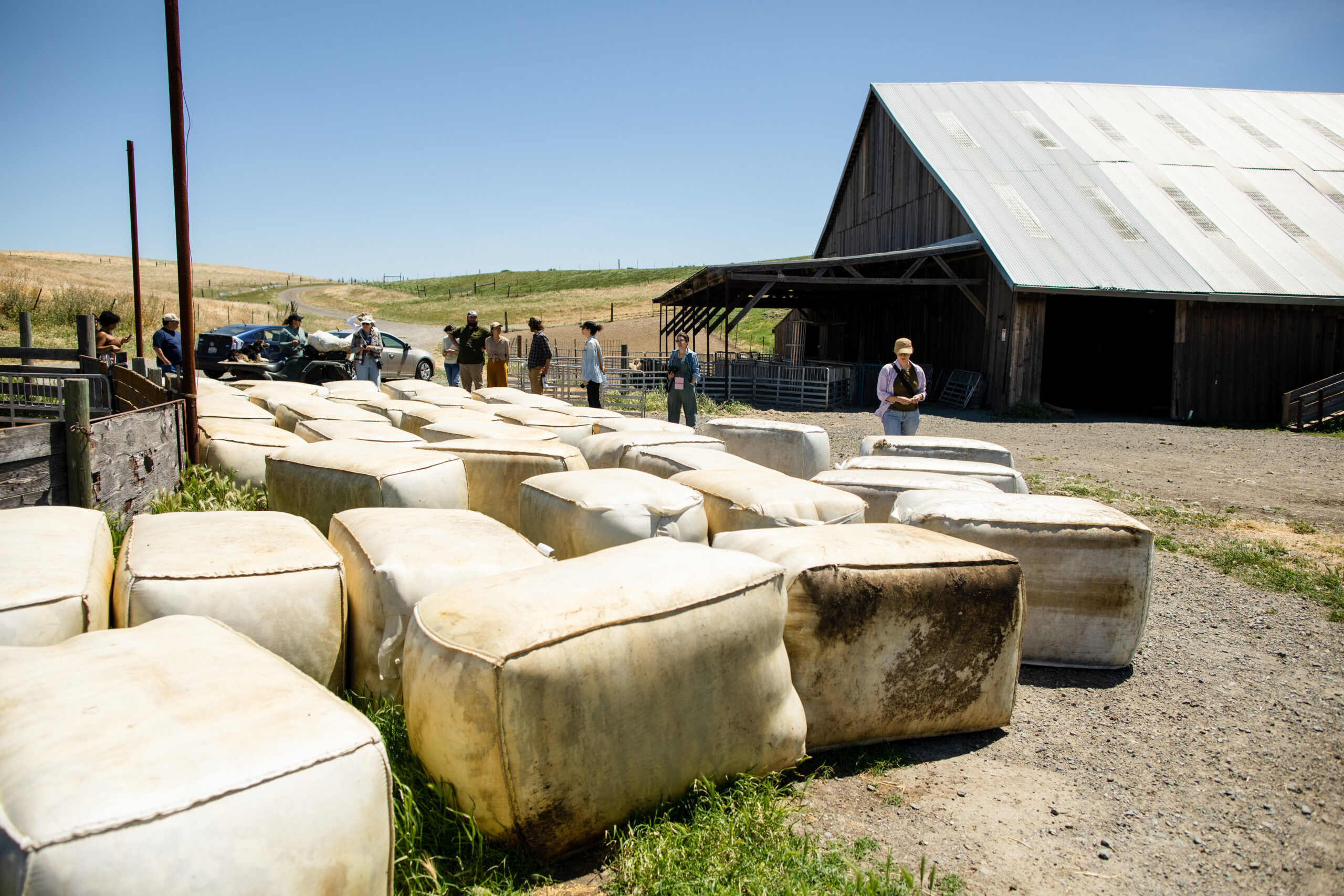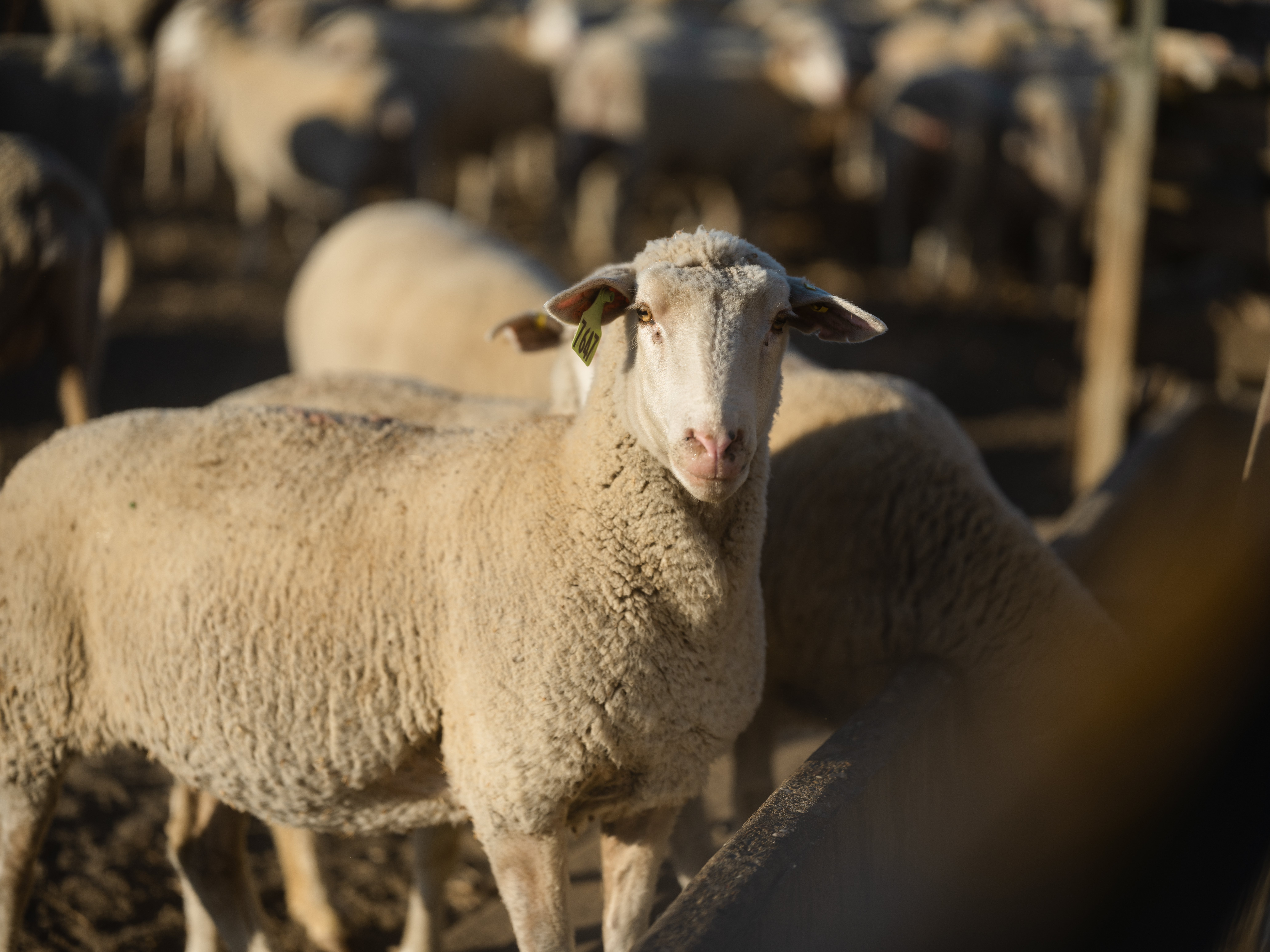Written by Stephany Wilkes. Photographed by Paige Green.

Kelsey Nichols is the Ranch Manager and Shepherd at McCormack Ranch in Rio Vista, California. Owned by Jeanne McCormack and her husband, Al Medvitz, the Ranch has provided natural, nutrient-dense meat and grain since 1896 – as long as the Ranch has practiced sustainable farming. Today, the Ranch raises and manages South African Meat Merino (SAMM) sheep that produce food and fine wool and play an important role in pasture management and implementation of the Ranch’s Carbon Farm Plan, created with the help of Fibershed and the Solano County Resource Conservation District (RCD).
“McCormack Ranch has always been a very holistic system,” Kelsey says. “Small grain farming and sheep fit really well together. The sheep cleaned up the fields to help control the weeds and, at the end of grain harvest, cleaned up the seeds. After harvest, the sheep went back on to control the weeds and stayed into the next year, when it’s pasture again. And then the Ranch had the meat from lambs and bread from the grain. It hasn’t changed too much since then.”
But change is afoot within this consistent pattern of conservation, in terms of grazing practices, dryland alfalfa experimentation, and ecologically-minded reduction of invasive species.

“We do a three-year rotational system, but I have been transitioning some of the ground to more permanent pasture,” Kelsey says. “Not to be grazed permanently, but to get away from destroying the ground.”
She explains that some of McCormack Ranch’s six square miles is leased to neighbors as grain ground. They fallow it in summer, when the sheep control the weeds, and then disc the ground in preparation for fall planting. The discing is what Kelsey wants to change, because it can damage soil structure and health over time.
“I want to improve the soil structure and get it to where we’re not turning up this ground and turning seeds – bad seeds – up,” Kelsey says. “We have done a fair bit of experimentation with dryland alfalfa, and the alfalfa mixed with the annuals makes a really great pasture mix.”
Improved forage for animals means less ground can support more animals, important for the Ranch’s overall efficiency and long-term sustainability, as well as local food security.
Alfalfa has a bad rap. It is one of California’s two most vilified “thirsty crops,” almonds being the other. Before the rainy winter of 2022-2023, the media periodically asked whether almonds and alfalfa should be grown at all. Dryland alfalfa, however, is not irrigated. It is a very drought-tolerant, perennial legume with deep tap roots.

“It likes our clay soil that holds the water deep,” Kelsey says. “We got a crop planted last January, a year and a half ago, and we had maybe an inch of rain after that. I thought it failed. I thought it all had died, because it all germinated and then was gone. But it all came back. You drive up the road, and it’s green, and to have green feed in the summer in California, not irrigated, is pretty incredible. It’s really exciting.”
As a legume, dryland alfalfa plays a part in the restoration of diverse ecological systems and habitat. Along with well-managed sheep, it supports the re-establishment of native perennial grasses, which reduces the use of herbicide sprays and fuel-powered mowing.
“If we can get these permanent pastures going, where we have the alfalfa for protein – for the sheep in the summer – along with whatever annuals come up, I actually think we’ll be able to decrease the weeds, and we will not have to do so many sprays. We want to get good grasses and legumes established that will help outcompete the invasives.”
Here, “invasive” means “more harmful than beneficial.” At McCormack Ranch, those invasive weeds include yellow starthistle, foxtails, black mustard, and pepperweed. They create monocultures by out-competing native grasses. Yellow starthistle is poisonous to horses, has a deep tap root (over three feet deep by late spring, on average) and, Kelsey says, “very high seed output and wind spread. And its seeds remain viable in soil for more than three years.”
All of this enables yellow starthistle to take hold over more shallow-rooted, annual species during California’s drier summer months, when surface moisture availability is limited due to seasonal lack of rainfall.
“This is why yellow starthistle survives so far into the summer, why I still see so much of it out here even after other annuals have dried up,” Kelsey says.

Healthy grasslands, by contrast, host and nourish native plants that sequester carbon deep in the soil and provide high-quality, diverse wildlife habitat. Healthy soils promote water infiltration, storing moisture during dry seasons and preventing run-off and erosion in increasingly severe rain storms. Unfortunately, at a time when we most need them, 97% of California’s native grasslands have been replaced by housing, non-native annual grasslands, and intensive forms of agriculture.
“I feel like there’s a growing number of people who think farmers are kind of evil,” Kelsey says. “That eating meat is bad for the environment, and shearing is harmful to sheep. And that’s just so, so out of touch with reality. There are a lot of pesticides used to grow your vegetables, and a lot of bugs that have died to feed you. That intensive style of crop agriculture has destroyed grassland and habitat for so many species. We want to reduce the use of pesticides and mowing as much as possible, which is where the sheep come in.”
Managing invasive species in an ecological way is difficult – logistically, financially, and due to the nature of the weeds themselves. Effective pasture management depends on the nuanced application of timing and sheep pressure. Grazing must be carefully managed with knowledge of the sort Kelsey has developed over the years.
“Overgrazing and rapid mowing can actually help invasives gain ground,” Kelsey explains. “Yellow starthistle can regrow after its top is removed by mowing or grazing. You want to time the grazing to reduce seed production. Unfortunately, the starthistle all bolts at once, and it is hard to target graze the starthistle this time of year, with so much annual grass that is more palatable.”
At the plant stage Kelsey describes, yellow starthistle has enough protein to meet the sheep’s basic nutritional needs.
“So we’re doing more intensive grazing in May and June, using larger numbers of animals for a short duration to get that weed height and seed production down, but without overgrazing. We don’t want more than half the grass forage to be removed, because that hurts the grasses’ recovery rate, and we need it to come back and shade out the starthistle. It loves light.”

Kelsey knows that re-establishing grasses and legumes will take years of diligent attention and work, but she’s up for the challenge – and excited about it. “It won’t be a single treatment or in a single year,” she says. “We have to suppress seed production while reestablishing competitors, and perennial grasses are slow to establish.” Once they are, though, properly timed grazing, mowing, and burning work more effectively.
Kelsey is quick to point out that “We can’t spray our way out of this. If we sprayed everything that we needed to, with the number of invasive species that are taking over, we would be bankrupt. I’m exaggerating, but these invasive species are that severe. And we just can’t get enough sheep on it. I would probably need to stock 100,000 sheep on this place for a month, and we don’t have the sheep numbers to be able to do that. And with the way starthistle seed blows in, everybody out there would need that treatment, too. We could do a lot more mowing but, again, that’s diesel and labor. Sprays are probably cheaper. That’s why people use them. It’s a really hard thing to balance, what’s environmentally friendly and what’s financially possible. Pasture improvement is a major way to address it, though.”
In addition to these efforts, McCormack Ranch has established a Fibershed-funded hedgerow and Kelsey is exploring how compost application might best support and enhance existing soil carbon-sequestration efforts. Whatever the particular stewardship technique, Kelsey Nichols will be there, astutely observing the plant mix and soil, understanding what is and is not working over time, and timing breeding and lambing to ensure feed availability and safety from winter storms, her keen eyes seeing how so much life responds.
McCormack Ranch is part of Fibershed’s Producer Network — a membership-based network of farmers, ranchers, designers, sewers, weavers, knitters, felters, spinners, mill owners, and natural dyers living and working within 51 counties in the North and Central regions of California. To connect with regional producers and their work, check out our Producer Directory.
Learn more about McCormack Ranch at their website: https://www.nimanranch.com/our-family-farmers/mccormack-family-lamb-ranch/ and sign up for their newsletter for the latest news and updates.
Interested in joining Fibershed’s producer community? Visit our Producer Program to learn more.
